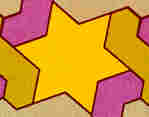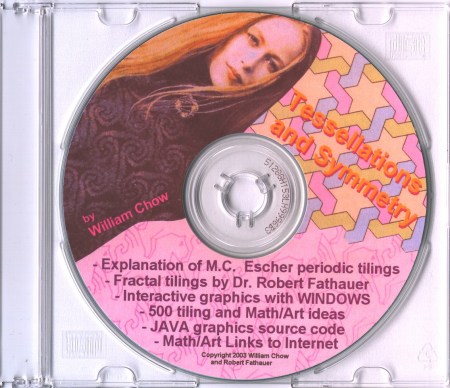Tessellations: Technology and Culture
Design is part of the human consciousness. Culture is how
people see and do things from a historical prospective.
The images shown here with the Java graphics are rooted
in thousands of years of use and living.
Escher began his regular plane division work in 1936 in
Spain. He got famous in the 50's. He was unique in his
vision and passion and he used to say "I'm walking
around all by myself here." His prints were all over USA
in the 60's when I was in college in Wisconsin and Michigan.
Five years after he died, in 1977 I did the computer programs
while I was teaching at the University of Illinois. That
was before the era of personal computers and desktop publishing.
I published my technical papers in 1979 and 1980. I have
collected images of regular plane division for quite a while.
It was not until I got on the Internet in 1997 that I see
other people doing Escher inspired art. The Internet made
a lot of resources available. So we don't feel the isolation
and loneliness that Escher expressed.
You can put an interlocking shape on the web by scanning or
computer paint programs(Adobe, Corel, etc.). That creates a
pixel based image. Some people asked me "Why use JAVA?" JAVA
programs are based on a mathematical description of the shape.
The colors are more uniform and the shapes have a simple clean
look. Because the size, color and angles are defined by a
set of parameters, the image can be changed dynamically while
the shape is shown on the webpage. I learn a lot more about
the geometry rules when I do the JAVA programs.
This is for your delight!
Enjoy the visual overload !
Quick Thumbnail samples
"Spirit of Escher" samples
Math/Art examples
Large and small squares
Herringbone Brick Pattern
 Sashiko - Classic Japanese quilt
Sashiko - Classic Japanese quilt
Chiyogami - Hand printed Japanese paper
FLAX Pattern 24K JPEG
Patchwork and Quilt
A Japanese Quilt Design
Islamic Tiles
Stars and Propellers(5/7/98)
Hexagons(8/2/2000)
Hexagram(3/8/2001)
Star of David Graphic image and
Comments, Reference, Links
Lattice window and tattoo babe 19K JPEG Warning: IMPURE
 Lattice Window in China
Lattice Window in China
Celtic stone carving
Celtic spirals28K JPEG
Sweater with regular scrolls by Alice Starmore, 25K JPEG
Koch Island(3/21/2001) a Fractal graphics
Twin Dragon a Julia set Fractal tiling (12/31/2001)
Java computer graphics is a good learning experience for junior
high school or middle school.
David made
these
pictures in junior high school.
LEGO tessellations
Build a spherical tessellations from a kit
Famous JAVA Graphics from award-winning programmers
The first 3 JAVA programs are copied from "JAVA-SIG's 100 best applets" edited by Robert Miller,
John Wiley and Sons, 1997.
Spiragraph by Anu Garg
Jav-A-Sketch by Mark Masse
Squiral by L. Ziegler
Penrose tiles by Geert
Calendar program by Michael Bertrand
Interactive pattern blocks by Jacobo Bulaevsky
Java Zip by Paul Friedlander
Mathematical Basis of Interlocking Shapes
Tessellations database by
Patrick Snels
REFEREBCES
"Visions of Symmetry - Notebooks, Periodic Drawings, and Related Work of
M. C. Escher" by Doris Schattschneider, W. H. Freeman and Company, New York,
1990, 354 pages.
"Tilings and Patterns" by Branko Grunbaum & G.C. Shepard, W.H. Freeman and Company, New York, 1986, 700 pages. This is a classic book, the best I have seen.
"Handbook of Regular Patterns" by Peter S. Stevens, MIT Press, 1981, 1996, 454 illustrations,
400 pages.
"Pattern Design" by Archibald H. Christie, Dover Publications Inc. New York, 1910, 1929,
U.S. Edition 1969, 359 illustrations, 313 pages.
"Chinese Lattice Designs" by Daniel Sheets Dye, Dover Publications, Inc. New York, 1937,
1949, 1974, 1239 illustrations, 469 pages.
"3000 Decorative Patterns of the Ancient World" by Flinders Petrie, Dover Book 1986, 106 pages.
"Jim Blinn's Corner: Dirty Pixels" by Jim Blinn at Microsoft Research, Morgan Kaufmann
Publication Inc., 1998, 247 pages.
"Symmetries of Culture," by Dorothy K. Washburn and Donald W. Crowe, University of Washington Press, 1988, 300 pages. This is considered an archaeology book, it has good discussion of symmetry in human history from different cultures.
"Multicultural Mathematics," by David Nelson, George Joseph and Julian Williams,
Oxford University Press, 1993, 228 pages.
"The Grammer of Ornament">by Owen Jones, A Dorling Kindersley Book, 2001, 504 pages
Why do JAVA or JavaScript?
I started using JAVA to do these tessellations in April 98.
JAVA is like C, which is a versatile programming language.
Doing graphics on the monitor with C is simple. JAVA graphics
output is limited to this sandbox on the webpage (of the browser).
The size and location of the sandbox is defined by HTML,
which invokes the JAVA applet. I learn to
use JavaScript to allow the viewer to interact with the Java
Virtual Machine. JavaScript is like REXX. It is good with
command parsing. JavaScript is perfect for interfacing JAVA
with the HTML script. What you see are the buttons that allow
you to change the image within the sandbox of JAVA graphics.
I feel the time invested in the JAVA language is well spent
because the language is so useful and there is a real commitment
from Sun Microsystem to make this a universal language.
Like other people I know, I learn this in my spare time
without formal training. This is because the language is well
designed and there are so many good books on the subject. It
helped me a lot to have people around like Steven, Gary Steiner,
Brian Fan and Galen Miller to bounce off ideas and questions.
Please send me an
email if you have an idea or something to say.
CD is available that contains 500 images, 50 graphic Java programs with source code, fast viewing for all designs without an Internet connections. I stopped adding contents to my website since 2001 because the ISP is charging me extra fee when the traffic gets too high and visitors are experiencing viewing problems. All my new ideas go into the CD. There are images not seen anywhere else. $20 cost for the CD includes US mailing postage. Satisfaction guaranteed or your money back. Please inquire with email. Special discount for schools and public library.

Tessellations CD
MathArtFun website


 Lattice Window in China
Lattice Window in China
